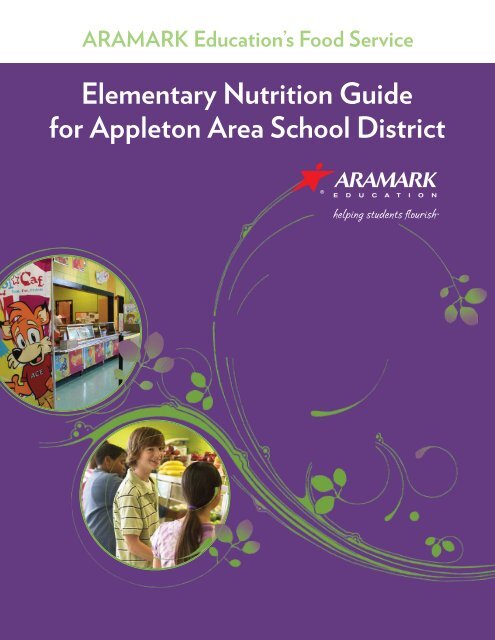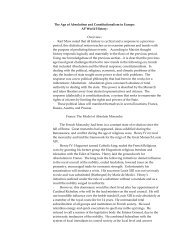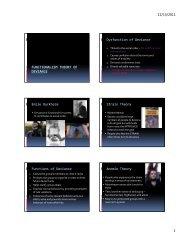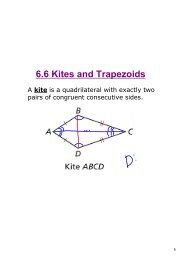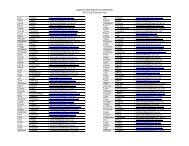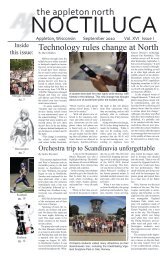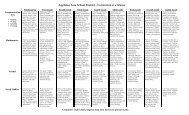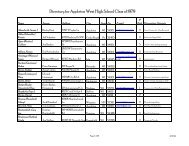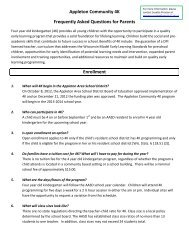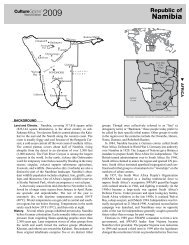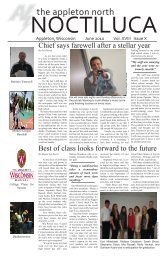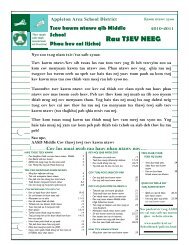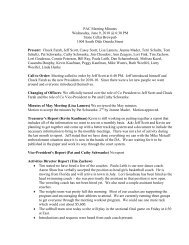Elementary Nutrition Guide for Appleton Area School District
Elementary Nutrition Guide for Appleton Area School District
Elementary Nutrition Guide for Appleton Area School District
Create successful ePaper yourself
Turn your PDF publications into a flip-book with our unique Google optimized e-Paper software.
ARAMARK Education’s Food Service<br />
<strong>Elementary</strong> <strong>Nutrition</strong> <strong>Guide</strong><br />
<strong>for</strong> <strong>Appleton</strong> <strong>Area</strong> <strong>School</strong> <strong>District</strong>
ELEMENTARY NUTRITION GUIDE<br />
Table of Content<br />
National <strong>School</strong> Breakfast Program (NSBP) 1<br />
National <strong>School</strong> Lunch Program (NSLP) 4<br />
Beyond Stereotypes—Facts About <strong>School</strong> Lunches 6<br />
USDA Recommended Daily Allowances 8<br />
Regulations <strong>for</strong> Offer Versus Serve (Lunch) 9<br />
<strong>Guide</strong> to Serving Size 10<br />
How to Read a <strong>Nutrition</strong>al Label 11
ELEMENTARY NUTRITION GUIDE<br />
We Pledge to Give You<br />
Something to Smile About<br />
ARAMARK Education’s Food Service Program aims to create a comprehensive<br />
approach to food service. We deliver results in several areas, including nutrition<br />
and wellness, increased participation, financial per<strong>for</strong>mance, and operational<br />
excellence. We are dedicated to supporting the goal of preparing children <strong>for</strong><br />
the learning process by providing healthy and nourishing meals. Our key<br />
commitment is to help students flourish.
ELEMENTARY NUTRITION GUIDE<br />
National <strong>School</strong> Breakfast Program<br />
Benefits of Breakfast<br />
Providing breakfast addresses legislative trends and growing media concern toward unhealthy children.<br />
Missing out on an important source of nutrients and vitamins early in the day leaves students without the<br />
energy and brainpower to meet and exceed their mental and physical potential. It also leaves them at higher<br />
risk <strong>for</strong> childhood diabetes and obesity, and increases the probability of unhealthy snacking and overeating<br />
later in the day.<br />
USDA <strong>Guide</strong>lines, National <strong>School</strong> Breakfast Program (NSBP)<br />
1. What is the National <strong>School</strong> Breakfast Program?<br />
The National <strong>School</strong> Breakfast Program is a federally assisted meal program operating in public and nonprofit<br />
private schools and residential child care institutions. It began as a pilot project in 1966 and was made permanent<br />
in 1975. The National <strong>School</strong> Breakfast Program is administered at the federal level by the Food and <strong>Nutrition</strong><br />
Service. At the state level, the program is usually administered by state education agencies, which operate the<br />
program through agreements with local school food authorities in nearly 80,000 schools and institutions.<br />
2. How does the National <strong>School</strong> Breakfast Program work?<br />
The National <strong>School</strong> Breakfast Program operates in the same manner as the National <strong>School</strong> Lunch<br />
Program. Generally, public or nonprofit private schools of high school grade or under and public or<br />
nonprofit private residential child care institutions may participate in the National <strong>School</strong> Breakfast<br />
Program. <strong>School</strong> districts and independent schools that choose to take part in the breakfast program<br />
receive cash subsidies from the U.S. Department of Agriculture (USDA) <strong>for</strong> each meal they serve. In return,<br />
they must serve breakfasts that meet federal requirements, and they must offer free or reduced-price<br />
breakfasts to eligible children.<br />
3. What are the nutritional requirements <strong>for</strong> school breakfasts?<br />
<strong>School</strong> breakfasts must meet the applicable recommendations of the Dietary <strong>Guide</strong>lines <strong>for</strong> Americans,<br />
which recommend that no more than 30 percent of an individual’s calories come from fat and less than 10<br />
percent from saturated fat. In addition, breakfasts must provide one-fourth of the Recommended Dietary<br />
Allowance <strong>for</strong> protein, calcium, iron, Vitamin A, Vitamin C, and calories. The decisions about the specific<br />
foods to serve and how they are prepared are made by local school food authorities.<br />
4. How do children qualify <strong>for</strong> free and reduced-price breakfasts?<br />
Any child at a participating school may purchase a meal through the National <strong>School</strong> Breakfast Program.<br />
Children from families with incomes at or below 130 percent of the federal poverty level are eligible <strong>for</strong> free<br />
meals. Those with incomes between 130 percent and 185 percent of the poverty level are eligible <strong>for</strong><br />
reduced-price meals. (For the period July 1, 2005, through June 30, 2006, 130 percent of the poverty level<br />
is $25,155 <strong>for</strong> a family of four; 185 percent is $35,798.) Children from families over 185 percent of poverty<br />
pay full price, though their meals are still subsidized to some extent.<br />
1
ELEMENTARY NUTRITION GUIDE<br />
The following statements are excerpted from Statement on the Link Between <strong>Nutrition</strong> and Cognitive<br />
Development in Children (1994) by the Center on Hunger, Poverty, and <strong>Nutrition</strong> Policy at Tufts University.<br />
"Children who attend school hungry have diminished attention spans and are unable to<br />
per<strong>for</strong>m tasks as well as their nourished peers. In these cases, the full value of the<br />
education provided is lost."<br />
"<strong>Nutrition</strong>ally deprived children are unable to benefit fully from schooling which, in turn,<br />
diminishes their potential as adults."<br />
"The benefits [of the <strong>School</strong> Breakfast Program] include higher per<strong>for</strong>mance on<br />
standardized tests, better school attendance, lowered incidence of anemia, and reduced<br />
need <strong>for</strong> costly special education."<br />
The following are quoted from Hunger in Children in the United States: Potential Behavioral and Emotional<br />
Correlates (1998) by Ronald Kleinman, et. al.<br />
"Children from families that report multiple experiences of food insufficiency and hunger<br />
are more likely to show behavioral, emotional, and academic problems..."<br />
"Chronic under-nutrition is associated with increased anxiety, attention deficits, increased<br />
prevalence of school absence, and tardiness..."<br />
"Problems such as fighting, stealing, and anxiety are more common in hungry...school-age<br />
children in our sample 5 to 10 years be<strong>for</strong>e they seem in society as increased rates of<br />
violence, underachievement, and substance abuse."<br />
<strong>School</strong>s may choose from two options <strong>for</strong> their Breakfast Program.<br />
2
BEFORE SCHOOL BREAKFAST<br />
The students arrive early to school, and breakfast is served be<strong>for</strong>e the start of classes in the cafeteria.<br />
This option often contains hot breakfast items. The students eat their breakfast in the cafeteria and then<br />
report to their homeroom class.<br />
An example breakfast:<br />
BREAKFAST IN THE CLASSROOM<br />
In this situation, breakfast is served in the classroom, either at the start of the day or as a morning<br />
nutrition break. The bagged breakfast meals are delivered to each classroom daily, and the children are<br />
given time to sit at their desks and eat their meal. This tends to be the more popular choice <strong>for</strong> breakfast<br />
in the schools.<br />
An example breakfast:<br />
Assorted cereal<br />
or<br />
Cheddar cheese omelet<br />
Whole grain blueberry muffin<br />
String cheese<br />
ELEMENTARY NUTRITION GUIDE<br />
3<br />
Whole wheat toast<br />
Juice<br />
Milk choice<br />
Fruit choice<br />
Milk choice
ELEMENTARY NUTRITION GUIDE<br />
National <strong>School</strong> Lunch Program<br />
1. What is the National <strong>School</strong> Lunch Program?<br />
The National <strong>School</strong> Lunch Program (NSLP) is a federally assisted meal program operating in more<br />
than 101,000 public and nonprofit private schools and residential child care institutions. In 2006, this<br />
program provided nutritionally balanced, low-cost, or free lunches to more than 30 million children<br />
each school day. In 1998, Congress expanded the National <strong>School</strong> Lunch Program to include<br />
reimbursement <strong>for</strong> snacks served to children in after-school educational and enrichment programs to<br />
include children through 18 years of age.<br />
The Food and <strong>Nutrition</strong> Service administers the program at the federal level. At the state level, the<br />
National <strong>School</strong> Lunch Program is usually administered by state education agencies, which operate<br />
the program through agreements with school food authorities.<br />
2. How does the National <strong>School</strong> Lunch Program work?<br />
Generally, public or nonprofit private schools of high school grade or under and public or nonprofit<br />
private residential child care institutions may participate in the National <strong>School</strong> Lunch Program. <strong>School</strong><br />
districts and independent schools that choose to take part in the lunch program receive cash subsidies<br />
and donated commodities from the United States Department of Agriculture (USDA) <strong>for</strong> each meal<br />
they serve. In return, they must serve lunches that meet federal requirements, and they must offer free<br />
or reduced-price lunches to eligible children. <strong>School</strong> food authorities can also be reimbursed <strong>for</strong> snacks<br />
served to children through age 18 in after-school educational or enrichment programs.<br />
4
ELEMENTARY NUTRITION GUIDE<br />
3. What are the nutritional requirements <strong>for</strong> school lunches?<br />
<strong>School</strong> lunches must meet the applicable recommendations of the Dietary <strong>Guide</strong>lines <strong>for</strong> Americans,<br />
which recommend that no more than 30 percent of an individual's calories come from fat and less than 10<br />
percent from saturated fat. Regulations also establish a standard <strong>for</strong> school lunches to provide one-third of<br />
the Recommended Dietary Allowances of protein, Vitamin A, Vitamin C, iron, calcium, and calories.<br />
<strong>School</strong> lunches must meet federal nutrition requirements, but decisions about the specific foods to serve<br />
and how they are prepared are made by local school food authorities.<br />
4. How do children qualify <strong>for</strong> free and reduced-price meals?<br />
Any child at a participating school may purchase a meal through the National <strong>School</strong> Lunch Program.<br />
Children from families with incomes at or below 130 percent of the poverty level are eligible <strong>for</strong> free meals.<br />
Those with incomes between 130 percent and 185 percent of the poverty level are eligible <strong>for</strong> reduced-price<br />
meals, <strong>for</strong> which students can be charged no more than 40 cents. (For the period July 1, 2007, through June<br />
30, 2008, 130 percent of the poverty level is $26,845 <strong>for</strong> a family of four; 185 percent is $38,203.)<br />
Children from families with incomes over 185 percent of poverty pay a full price, though their meals are<br />
still subsidized to some extent. Local school food authorities set their own prices <strong>for</strong> full-price (paid)<br />
meals, but must operate their meal services as nonprofit programs.<br />
After-school snacks are provided to children on the same income eligibility basis as school meals.<br />
However, programs that operate in areas where at least 50 percent of students are eligible <strong>for</strong> free or<br />
reduced-price meals may serve all their snacks <strong>for</strong> free.<br />
5
Beyond the Stereotypes<br />
Facts About <strong>School</strong> Lunches<br />
ELEMENTARY NUTRITION GUIDE<br />
The reality of school nutrition programs is too often ignored in favor of a ratings boost based on<br />
stereotypes and biased in<strong>for</strong>mation. <strong>School</strong> lunches today follow federal nutrition guidelines and serve<br />
more fresh fruits and vegetables, whole grains, and low-fat dairy than ever be<strong>for</strong>e. On a very tight<br />
budget, school nutrition professionals are preparing and serving balanced, nutritious meals in an ageappropriate<br />
portion size that provides needed nutrients and promotes a healthy childhood weight.<br />
Myth Number One—<strong>School</strong> meals make children obese.<br />
Fact: Students who eat meals served through the National <strong>School</strong> Lunch Program are more likely to be at<br />
a healthy weight. Research published in the August 2003 issue of Archives of Pediatric and Adolescent<br />
Medicine concluded that “girls in food insecure households had significantly reduced odds of being at<br />
risk of overweight if they participated in the [National <strong>School</strong> Lunch, <strong>School</strong> Breakfast and Food Stamp<br />
Programs].” The research highlights the importance of food assistance programs to low-income children<br />
not only in addressing hunger “but also in potentially protecting them from excess weight gain." i] NSLP<br />
participants are more likely than non-participants to consume vegetables, milk and milk products, and<br />
meat and other protein-rich foods, both at lunch and over 24 hours; they also consume less soda and/or<br />
fruit drinks. [ii]<br />
Myth Number Two—<strong>School</strong>s serve junk food <strong>for</strong> school lunch.<br />
Fact: Meals served under the National <strong>School</strong> Lunch Program must, by federal law, meet <strong>Nutrition</strong><br />
guidelines based on the Dietary <strong>Guide</strong>lines <strong>for</strong> Americans. No more than 30 percent of calories can<br />
come from fat and less than 10 percent from saturated fat. <strong>School</strong> lunches provide one-third of the<br />
Recommended Dietary Allowances of protein, Vitamin A, Vitamin C, iron, calcium, and calories. These<br />
guidelines apply over the course of one week of school lunch menus. The 2001 <strong>School</strong> <strong>Nutrition</strong> and<br />
Dietary Assessment II (SNDA II) study based on research by the U.S. Department of Agriculture during<br />
the 1998–1999 school year found that students in 91 percent of secondary schools and 82 percent of<br />
elementary schools had the opportunity to select lunches that were consistent with dietary standards <strong>for</strong><br />
fat and saturated fat. [iii] National <strong>School</strong> Lunch Program participation is associated with higher average<br />
intakes of many nutrients, both at lunch and over 24 hours. NSLP participants have substantially lower<br />
intakes of added sugars than do non-participants. [ii]<br />
Myth Number Three—<strong>School</strong>s don’t serve enough fruits or vegetables <strong>for</strong> lunch.<br />
Fact: According to the <strong>School</strong> <strong>Nutrition</strong> Dietary Assessment II, approximately two-thirds of all school lunch<br />
menus offer more than the required two fruit and vegetable choices set by USDA regulations. [iii] The 2005<br />
<strong>School</strong> Foodservice and <strong>Nutrition</strong> Operations Survey Report conducted by SNA found that fresh fruits and<br />
vegetables are offered daily in 85 percent of high schools. [iv]<br />
Furthermore, salad bars are offered on a daily basis in over half of districts (at least one school per<br />
district) in the country [iv] . Vegetarian options are served in more than 30 percent of middle schools and<br />
high schools around the country, according to the 2005 SNA Operations Survey Report.<br />
6
ELEMENTARY NUTRITION GUIDE<br />
Myth Number Four—<strong>School</strong>s serve fried, greasy foods.<br />
Fact: <strong>School</strong>s may serve french fries, chicken nuggets, or pizza at times. However, because the meals are<br />
always required to meet the Recommended Dietary Allowances, the foods still meet required nutrition<br />
standards, including limits on fat and saturated fat. This is because they are often baked, not fried, made<br />
with low-fat or lean ingredients, and served with vegetables, fruit, and other options that make each meal<br />
balanced and nutritious.<br />
Myth Number Five—Sack lunches from home are better than school meals.<br />
Fact: Research by Dr. Alice Jo Rainville of Eastern Michigan University concluded that students who eat<br />
school lunches consume less calories from fat than students who bring their lunch from home. Furthermore,<br />
the research found school lunches contain three times as many dairy products, twice as much fruit, and<br />
seven times the vegetable amounts as lunches brought from home. [v]<br />
Myth Number Six—Soda is served with school lunch.<br />
Fact: Federal law prohibits the sale of soda as a Food of Minimal <strong>Nutrition</strong>al Value (FMNV) in the cafeteria<br />
during the school lunch period. State and local regulations may further prohibit the sale of soda be<strong>for</strong>e or<br />
after the lunch period or in other locations on the school campus.<br />
Myth Number Seven—Only junk food is available through à la carte lines and vending machines.<br />
Fact: While few federal nutrition standards exist <strong>for</strong> à la carte and vended foods and beverages, school<br />
nutrition professionals are an active part of the national trend at the state and local levels to implement<br />
nutrition standards these items. <strong>School</strong> nutrition professionals help set nutrition policies at the local level<br />
through their state and school board. Through federally mandated local school wellness policies, school<br />
nutrition professionals are joining with parents, students, and other school stakeholders to implement<br />
nutrition guidelines <strong>for</strong> all foods and beverages sold on school campuses. The <strong>School</strong> <strong>Nutrition</strong> Association<br />
actively calls on Congress to pass the Child <strong>Nutrition</strong> Promotion and <strong>School</strong> Lunch Protection Act in order<br />
to give the USDA the authority to set nutrition standards <strong>for</strong> all I foods and beverages available in schools.<br />
Myth Number Eight—What is served at schools is out of my control.<br />
Fact: You can become active in setting policies at the local level. Join your local school board or write a<br />
letter and voice what you think schools should offer students. Wellness is a community ef<strong>for</strong>t and needs the<br />
support of the entire community. <strong>School</strong> nutrition professionals are committed to providing safe and<br />
nutritious meals to all children. Parents are encouraged to visit their student’s cafeteria, try a lunch, and talk<br />
to their school food service director about the nutritional profile of foods served.<br />
[i] Jones et al. Lower Risk of Overweight in <strong>School</strong>-Aged Food Insecure Girls Who Participate in Food<br />
Assistance, Archives of Pediatric and Adolescent Medicine, August 2003.<br />
[ii] Mathematical Policy Research, Inc. Final report submitted to the U.S. USDA of Agriculture. Children’s<br />
Diets in the Mid-1990s. Dietary Intake and Its Relationship with <strong>School</strong> Meal Participation. 2001.<br />
[iii] US Department of Agriculture. <strong>School</strong> <strong>Nutrition</strong> and Dietary Assessment II, April 2001.<br />
[iv] <strong>School</strong> <strong>Nutrition</strong> Association, 2005 <strong>School</strong> Foodservice and <strong>Nutrition</strong> Operations Survey, March 2005.<br />
[v] Rainville, A. <strong>Nutrition</strong>al Quality of Reimbursable <strong>School</strong> Lunches Compared to Lunches Brought from<br />
Home, The Journal of Child <strong>Nutrition</strong> & Management, Spring 2001.<br />
7
ELEMENTARY NUTRITION GUIDE<br />
USDA Recommended Daily Allowances<br />
The USDA and the Wisconsin Department of Public Instruction has set standard minimum recommended<br />
daily allowances <strong>for</strong> elementary students’ nutrition. As a member of the NSBP and NSLP, ARAMARK<br />
Education’s Food Service Program at AASD must maintain these standards and will undergo regular<br />
inspections by the state and federal governments. These inspections review menus and regulatory guidelines<br />
to ensure that all requirements are met. Listed below are the current average daily nutritional guidelines <strong>for</strong><br />
your child’s breakfast and lunch meal, averaged over the period of one week.<br />
AVERAGE DAILY NUTRITION<br />
GUIDELINES FOR BREAKFAST<br />
Calories 554<br />
Total fat
ELEMENTARY NUTRITION GUIDE<br />
FOOD COMPONENTS AND FOOD ITEMS MINIMUM QUANTITIES<br />
Milk 8 fl. oz. (1 cup)<br />
Meat or Meat Alternative<br />
<strong>School</strong> Lunch Tray<br />
Lean meat, poultry, or fish<br />
Alternate protein products<br />
Cheese<br />
Egg (large)<br />
Cooked dry beans or peas<br />
Peanut butter or other nut/seed butters<br />
Yogurt<br />
Fruit or Milk Fruit or<br />
Veggie Veggie<br />
Bread Meat<br />
Offer versus Serve<br />
Your tray must have three of five, but it’s wise to eat all five!<br />
Traditional Food-Based Menu Planning—Meal Pattern<br />
Vegetable or Fruit—Two or more servings of different vegetables,<br />
fruits, or both<br />
Grains and Breads—Must be enriched whole grain, or made from<br />
enriched or whole-grain flour or meal that may include bran and/or<br />
germ. A serving is a slice of bread or an equivalent serving of<br />
biscuits, rolls, etc., or ½ cup of cooked rice, pasta, or cereal grains.<br />
9<br />
¾ cup<br />
2 oz.<br />
2 oz.<br />
2 oz.<br />
1 large egg<br />
1 ⁄2 cup<br />
4 Tbsp.<br />
12 oz.<br />
(1 1 ⁄2 cups)<br />
8 per week—minimum<br />
of 1 per day
<strong>Guide</strong> to Serving Size<br />
ELEMENTARY NUTRITION GUIDE<br />
3 ounces<br />
1 serving of meat, chicken, turkey, or fish<br />
1 cup<br />
1 serving of cooked vegetables, salads,<br />
casseroles or stews, and milk<br />
1 ounce<br />
1 serving of snack foods, cheese<br />
1 tablespoon<br />
1 serving of salad dressing, cream cheese<br />
1 tablespoon<br />
1 serving of margarine or butter, oil, or<br />
mayonnaise<br />
1/2 cup<br />
1 serving of fruit or fruit juice, starchy<br />
vegetables, beans, rice or noodles, cereal<br />
10
ELEMENTARY NUTRITION GUIDE<br />
Regulations <strong>for</strong> Offer Versus Serve (Lunch)<br />
Lunches are required to offer five food items in the specified amounts. These food items are meat/meat<br />
alternate, grains/breads, two servings of vegetables/fruits, and milk. Students must select a minimum of<br />
three items of the five items offered in the minimum serving size required <strong>for</strong> the specified age groups.<br />
We offer a total of five entrées each day along with a minimum of two sides of a fruit and vegetable and milk.<br />
Examples of a Reimbursable Meal<br />
THE MENU THE CUSTOMER TOOK<br />
Grilled ham and cheese sandwich Veggie burger on a bun<br />
Chef salad Diced peaches<br />
Turkey ranch wrap Milk choice<br />
Peanut butter and jelly sandwich<br />
Veggie burger on a bun<br />
Tomato soup<br />
Diced peaches<br />
Milk<br />
THE MENU THE CUSTOMER TOOK<br />
Chicken patty on a bun Chef salad with dressing<br />
Peanut butter and jelly sandwich Orange wedges<br />
Ham and cheese sandwich Graham crackers<br />
Chef salad Milk<br />
Veggie burger on a bun<br />
Carrot coins<br />
Orange wedges<br />
Graham crackers<br />
Milk<br />
Pictured: The Garden Cart<br />
Students are encouraged to take as<br />
many fruits and vegetables as they<br />
think they can eat.<br />
11
ELEMENTARY NUTRITION GUIDE<br />
How to Read a <strong>Nutrition</strong> Label<br />
Pay close attention to the number of servings per package.<br />
The nutrition facts label is based on a 2,000-calorie diet consider that in your<br />
meal planning.<br />
Divide the calories from fat by the total calories to get the percentage of fat of that<br />
product. You want to stay under 30 percent.<br />
The % DV helps you determine if a serving of food is high or low in a nutrient—5 percent<br />
or less is low and 20 percent or more is high.<br />
Always look at the ingredients.<br />
12
©2010 ARAMARK. All rights reserved.


